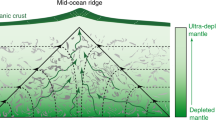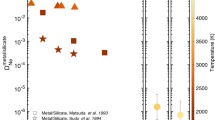Abstract
The average compositions (including H2O, Cl, F, and S contents) and chemical structure of oceanic mantle plumes were estimated on the basis of the ratios of incompatible volatile components, potassium, and some other elements in the basaltic magmas of ocean islands (melt inclusions and quenched glasses). The following average concentrations were estimated for the plume mantle: 510 ppm K2O, 520 ppm H2O, 21 ppm Cl, 55 ppm F, and 83 ppm S; these values are significantly higher than those of the depleted mantle (except for S). The abundances of H2O, Cl, and S are lower than in the primitive mantle. The normalized H2O content in the plume mantle is similar to the concentrations of similarly incompatible La and Ce but lower than the concentrations of K2O, Cl, and Sr. This is at odds with the idea of wet mantle plumes. Three types of basaltic magmas corresponding to three types of plume sources (M1, M2, and M3) were distinguished. The concentrations of incompatible elements in these reservoirs were estimated using two models, assuming either an isochemical mantle or a moderately enriched composition of plume material. The latter model gave the following average concentrations of H2O, Cl, F, and S: 130, 33, 11, and 110 ppm for M1, 110, 12, 65, and 45 ppm for M2; 530, 29, 49, and 110 ppm for M3. The plume mantle is not homogeneous, and its heterogeneity is related to the existence of three main compositions, one of which (M1) is similar to the mantle of mid-ocean ridges, and two others (M2 and M3) are moderately enriched in K2O, TiO2, P2O5, F, and incompatible trace elements. The compositions of M2 and M3 are strongly different in H2O, Cl, and S contents. The M2 mantle reservoir is significantly poorer in these components and richer in incompatible trace elements than M3. The plume mantle was formed mainly by the mixing of three sources: ultradepleted mantle, moderately enriched relatively dry mantle, and moderately enriched H2O-rich mantle. In addition to the three main components of the plume mantle, there are probably minor components enriched in chlorine and depleted in fluorine. It is supposed that all these components are entrained into the plume mantle through the mantle recycling of components of the oceanic and continental crust. The established relationships are in agreement with the zonal model of a mantle plume, which includes a hot central part poor in H2O, Cl, and S; an outer part enriched in volatile and nonvolatile incompatible elements; and enclosing mantle material interacting with the plume.
Similar content being viewed by others
References
F. Brunet and G. Chazot, “Partitioning of Phosphorus between Olivine, Clinopyroxene and Silicate Glass in a Spinel Lherzolite Xenolith from Yemen,” Chem. Geol. 176, 51–72 (2001).
J. E. Dixon and D. A. Clague, “Volatiles in Basaltic Glasses from Loihi Seamount, Hawaii: Evidence for a Relatively Dry Plume Component,” J. Petrol. 42, 627–654 (2001).
J. E. Dixon, E. M. Stolper, and J. R. Delaney, “Infrared Spectroscopic Measurements of CO2 and H2O Glasses in the Juan De Fuca Ridge Basaltic Glasses,” Earth Planet. Sci. Lett. 90, 87–104 (1988).
J. E. Dixon, L. Leist, Ch. Langmuir, and J.-G. Schilling, “Recycled Dehydrated Lithosphere Observed in Plume-Influenced Mid-Oceanic-Ridge Basalts,” Nature 420, 385–389 (2002).
M. O. Garcia, D. W. Muenow, K. E. Aggrey, and J. R. O’Neil, “Major Element, Volatile, and Stable Isotope Geochemistry of Hawaiian Submarine Tholeiitic Glasses,” J. Geophys. Res. 94, 10525–10538 (1989).
D. H. Green, J. Falloon, S. M. Eggins, and G. M. Yaxley, “Primary Magmas and Mantle Temperatures,” Eur. J. Mineral. 13, 437–451 (2001).
E. Hauri, “SIMS Analysis of Volatiles in Silicate Glasses, 2: Isotopes and Abundances in Hawaiian Melt Inclusions,” Chem. Geol. 183, 115–141 (2002).
E. H. Hauri, J. A. Whitehead, and S. R. Hart, “Fluid Dynamic and Geochemical Aspects of Entrainment in Mantle Plumes,” J. Geophys. Res. 99, 24275–24300 (1994).
G. Hirth and D. L. Kohlstedt, “Water in the Oceanic Upper Mantle: Implications for Rheology, Melt Extraction and the Evolution of the Lithosphere,” Earth Planet. Sci. Lett. 144, 93–108 (1996).
A. W. Hofmann, “Mantle Geochemistry: The Message from Oceanic Volcanism,” Nature 385, 219–229 (1997).
A. W. Hofmann, “Sampling Mantle Heterogeneity through Oceanic Basalts: Isotopes and Trace Elements,” in Treatise on Geochemistry (Elsevier, Amsterdam, 2003), Vol. 2, pp. 61–101.
M. B. Kamenetsky, A. V. Sobolev, V. S. Kamenetsky, et al., “Kimberlite Melts Rich in Alkali Chlorides and Carbonates: A Potent Metasomatic Agent in the Mantle,” Geology 32, 845–848 (2004).
V. I. Kovalenko, V. B. Naumov, V. V. Yarmolyuk, et al., “Balance of H2O and Cl between the Earth’s Mantle and Outer Shells,” Geokhimiya, No. 10, 1041–1070 (2002) [Geochem. Int. 40, 929–942 (2002)].
V. I. Kovalenko, A. V. Girnis, V. A. Dorofeeva, et al., “Magma Sources of Ocean Islands,” Dokl. Akad. Nauk 398, 379–384 (2004) [Dokl. Earth Sci. 398, 995–1000 (2004)].
V. I. Kovalenko, V. B. Naumov, A. V. Girnis, et al., “Estimation of the Average Contents of H2O, Cl, F, and S in the Depleted Mantle on the Basis of the Compositions of Melt Inclusions and Quenched Glasses of Mid-Ocean Ridge Basalts,” Geokhimiya, No. 3, 243–266 (2006a) [Geochem. Int. 44, 209–231 (2006a)].
V. I. Kovalenko, V. B. Naumov, A. V. Girnis, et al., “Volatiles in the Basaltic Magmas and Mantle Sources of Oceanic Islands: I. Estimation of the Melt Composition on the Basis of the Composition of Melt Inclusions and Rock Glasses,” Geokhimiya (2006b) (in press).
V. I. Kovalenko, V. B. Naumov, A. V. Girnis, et al., “Volatiles in the Basaltic Magmas and Mantle Sources of Oceanic Islands: II. Estimation of the Contents in Mantle Reservoirs,” Geokhimiya (2006c) (in press).
J. C. Lassiter, E. H. Hauri, I. K. Nikogosian, and H. G. Barsczus, “Chlorine-Potassium Variations in Melt Inclusions from Raivavae and Rapa, Austral Islands: Constraints on Chlorine Recycling in the Mantle and Evidence for Brine-Induced Melting of Oceanic Crust,” Earth Planet. Sci. Lett. 202, 525–540 (2002).
S. Maaloe, “Estimation of the Degree of Partial Melting Using Concentration Ratios,” Geochim. Cosmochim. Acta 58, 2519–2525 (1994).
A. G. Magenheim, A. G. Spivack, P. J. Michael, and J. M. Gieskes, “Chlorine Stable Isotope Composition of the Oceanic Crust: Implication for the Earth’s Distribution of Chlorine,” Earth Planet. Sci. Lett. 131, 427–432 (1995).
D. Massare, N. Metrich, and R. Clocchiatti, “High-Temperature Experiments on Silicate Melt Inclusions in Olivine at 1 atm: Inference on Temperatures of Homogenization and H2O Concentrations,” Chem. Geol. 183, 87–98 (2002).
W. F. McDonough, S. S. Sun, A. E. Ringwood, et al., “K, Rb and Cs in the Earth and Moon and the Evolution of the Mantle of the Earth,” Geochim. Cosmochim. Acta 56, 1001–1012 (1992).
P. Michael, “Regionally Distinctive Sources of Depleted MORB: Evidence from Trace Elements and H2O,” Earth Planet. Sci. Lett. 131, 301–320 (1995).
V. B. Naumov, V. I. Kovalenko, V. V. Yarmolyuk, and V. A. Dorofeeva, “Volatile Components (H2O, Cl, F, S, and CO2) in Magmatic Melts of Various Geodynamic Environments,” Geokhimiya, No. 5, 555–564 (2000) [Geochem. Int. 38, 500–509 (2000)].
V. B. Naumov, V. I. Kovalenko, V. V. Yarmolyuk, and V. A. Dorofeeva, “Average Concentrations of Major, Volatile, and Trace Elements in Magmas of Various Geodynamic Settings,” Geokhimiya, No. 10, 1113–1124 (2004) [Geochem. Int. 42, 977–987 (2004)].
H. Palme and H. St. C. O’Neill, “Cosmochemical Estimates of Mantle Composition,” in Treatise on Geochemistry (Elsevier, Amsterdam, 2003), Vol. 2, pp. 1–38.
P. Philippot, P. Agrinier, and M. Scambelluri, “Chlorine Cycling during Subduction of Altered Oceanic Crust,” Earth Planet. Sci. Lett. 161, 33–44 (1998).
Z. Quin, F. Lu, and A. T. Anderson, “Diffusive Re-Equilibration of Melt and Fluid Inclusions,” Am. Mineral. 77, 565–576 (1992).
A. B. Ronov, A. A. Yaroshevskii, and A. A. Migdisov, Chemical Structure of the Earth’s Crust and Geochemical Balance of Major Elements (Nauka, Moscow, 1990) [in Russian].
R. L. Rudnick and S. Gao, “Composition of the Continental Crust,” in Treatise on Geochemistry (Elsevier, Amsterdam, 2003), Vol. 3, pp. 1–64.
I. D. Ryabchikov, Thermodynamic Analysis of the Behavior of Minor Elements during Silicate Melt Crystallization (Nauka, Moscow, 1965) [in Russian].
A. E. Saal, E. H. Hauri, C. H. Langmuir, and M. R. Perfit, “Vapour Undersaturation in Primitive Mid-Ocean-Ridge Basalt and the Volatile Content of Earth’s Upper Mantle,” Nature 419, 451–455 (2002).
V. J. M. Salters and A. Stracke, “The Composition of the Depleted Mantle,” Geochem. Geophys. Geosyst. 5(5), 1–27 (2004).
J.-G. Schilling, M. B. Bergeron, and R. Evans, “Halogens in the Mantle beneath the North Atlantic,” Philos. Trans. R. Soc. London A297, 147–178 (1980).
G. Sen, A. Macfarlane, and N. Srimal, “Significance of Rare Hydrous Alkaline Melts in Hawaiian Xenoliths,” Contrib. Mineral. Petrol. 122, 415–427 (1996).
D. M. Shaw, “Trace Element Fractionation during Anatexis,” Geochim. Cosmochim. Acta 34, 237–243 (1970).
K. Simons, J. Dixon, J.-G. Schilling, et al., “Volatiles in Basaltic Glasses from the Easter-Salas y Gomez Seamount Chain and Easter Microplate: Implication for Geochemical Cycling of Volatile Elements,” Geochem. Geophys. Geosyst. 3(7), 1–29 (2002).
A. V. Sobolev and L. V. Danyushevsky, “Petrology and Geochemistry of Boninites from the North Termination of the Tonga Trench: Constraints on the Generation Conditions of Primary High Ca Boninite Magmas,” J. Petrol. 35, 1183–1211 (1994).
A. V. Sobolev, A. W. Hofmann, S. V. Sobolev, and I. K. Nikogosian, “An Olivine-Free Mantle Source of Hawaiian Shield Basalts,” Nature 434, 590–597 (2005).
R. K. Workman and S. R. Hart, “Major and Trace Element Composition of the Depleted MORB Mantle (DMM),” Earth Planet. Sci. Lett. 231, 53–72 (2005).
Author information
Authors and Affiliations
Additional information
Original Russian Text © V.I. Kovalenko, V.B. Naumov, A.V. Girnis, V.A. Dorofeeva, V.V. Yarmolyuk, 2006, published in Petrologiya, 2006, Vol. 14, No. 5, pp. 482–507.
Rights and permissions
About this article
Cite this article
Kovalenko, V.I., Naumov, V.B., Girnis, A.V. et al. Composition and chemical structure of oceanic mantle plumes. Petrology 14, 452–476 (2006). https://doi.org/10.1134/S0869591106050031
Received:
Issue Date:
DOI: https://doi.org/10.1134/S0869591106050031




